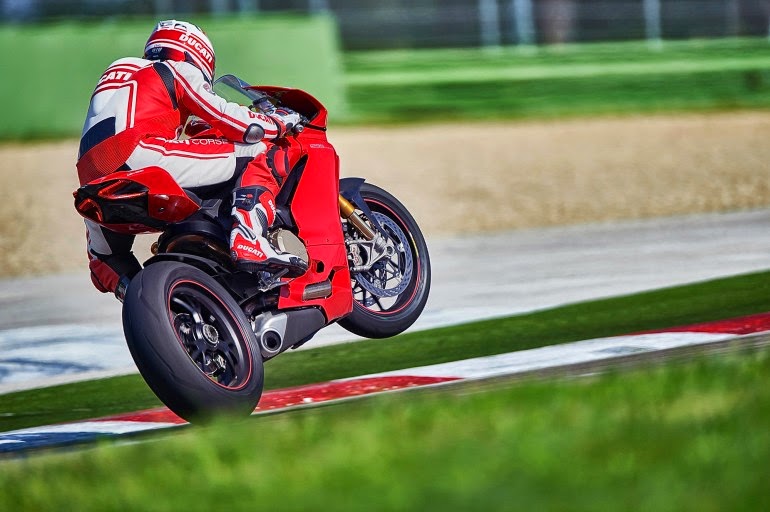Ducati's flagship bike Panigale just got bore out from 1199 to 1299 and officially cracked the 200-hp mark!
When Ducati CEO Claudio Domenicali was asked about the internal geometry of the Panigale 1199 engine—with specific reference to the rod length of 110.1mm in relation to its 60.8mm stroke—he affirmed that he wanted the Panigale to be as compact and well balanced as possible. When I heard a larger-displacement Panigale was in the works, with the extra cubes coming from increased stroke (the bore already was a record-setting 112mm), I wondered if Domenicali was ready to compromise with even shorter rods to compensate for the extra stroke.
OHH, dead wrong! Domenicali went for an even bigger bore: 116mm! Together with an unaltered stroke of 60.8mm, that makes for an actual displacement of 1,285cc. That’s the way, Claudio. Well done!
The new Panigale 1299 sets fresh standards in the superbike fraternity, with a claimed 205 hp at 10,500 rpm and a terrific 106.7 pound-feet of torque at 8,750 rpm. Simply put, there is nothing like that on two wheels, with the possible exception of the new supercharged special from Japan. Valve size is the same as that used in the 1199: 46.8mm titanium intakes, 38.2mm steel exhausts. By keeping the same valve and port size of the 1199, Ducati engineers have created a more flexible and torquey powerplant. The higher speed of the intake charge helps disprove the old notion that extremely oversquare engines must have poor torque curves.
The Panigale in its original 1,198cc displacement remains only as a race version—the Panigale R. This machine, with technical solutions extracted from the limited-edition 1199 Superleggera, features titanium valves and connecting rods, plus an ultra-compact crankshaft is a polished piece that features tungsten inserts for perfect balance. The claimed dry weight of this race Panigale R is now a svelte 357 pounds.
When Ducati CEO Claudio Domenicali was asked about the internal geometry of the Panigale 1199 engine—with specific reference to the rod length of 110.1mm in relation to its 60.8mm stroke—he affirmed that he wanted the Panigale to be as compact and well balanced as possible. When I heard a larger-displacement Panigale was in the works, with the extra cubes coming from increased stroke (the bore already was a record-setting 112mm), I wondered if Domenicali was ready to compromise with even shorter rods to compensate for the extra stroke.
OHH, dead wrong! Domenicali went for an even bigger bore: 116mm! Together with an unaltered stroke of 60.8mm, that makes for an actual displacement of 1,285cc. That’s the way, Claudio. Well done!
The new Panigale 1299 sets fresh standards in the superbike fraternity, with a claimed 205 hp at 10,500 rpm and a terrific 106.7 pound-feet of torque at 8,750 rpm. Simply put, there is nothing like that on two wheels, with the possible exception of the new supercharged special from Japan. Valve size is the same as that used in the 1199: 46.8mm titanium intakes, 38.2mm steel exhausts. By keeping the same valve and port size of the 1199, Ducati engineers have created a more flexible and torquey powerplant. The higher speed of the intake charge helps disprove the old notion that extremely oversquare engines must have poor torque curves.
The Panigale in its original 1,198cc displacement remains only as a race version—the Panigale R. This machine, with technical solutions extracted from the limited-edition 1199 Superleggera, features titanium valves and connecting rods, plus an ultra-compact crankshaft is a polished piece that features tungsten inserts for perfect balance. The claimed dry weight of this race Panigale R is now a svelte 357 pounds.
For more agile steering response, Ducati has given the
Panigale 1299 24 degrees of steering rake, which is a half-degree less than the
1199. Trail is consequently down from 100 to 96mm. Even more meaningful: The
swingarm pivot has been lowered 4mm, for better geometry to the front sprocket
and superior traction. Also, as before, there are two versions, standard and an
S model. The former is fitted with an inverted 50mm Marzocchi fork, a
gas-charged unit made of aluminum. The S bumps up the hardware quotient with
full LED headlights and Öhlins electronically managed semi-active suspension featuring
an inverted 43mm fork. Brakes on both bikes are by Brembo, with M50 calipers
acting upon a pair of 330mm front discs. To tame all that power and torque, the
electronics suite of these 1299 Panigales is among the most complete in
production today.













No comments:
Post a Comment